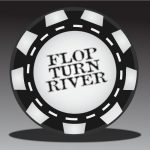After the Big 10 starting hands, I do not necessarily automatically raise pre-flop from any position. My play becomes more selective.
Group 3: AQ 99 88 77 ATs KJs
Sklansky’s Group 3 has been slightly re-arranged by the Carnegie Mellon group, which I’ve further
modified in the ranking above. I’ve moved AQ to the top of the Group 3, and also moved
99 to the second position, because in the game of no limit
holdem I feel these hand plays much better (I will further explain this below).
For these Group 3 hands, I look to raise pre-flop with the first two hands (AQ, 99),
from any position if there have not been any raises.
My raise will tend to be smaller, $1-$2.50 depending on my position and the table environment.
It will be less in early position and a little more in later position.
I look to raise pre-flop with the second four hands (88, 77, ATs, KJs),
in mid to late position if there have not been any raises, again in the range of $1-$2.
If I am faced with a raise, I will probably call if it is small on AQ, 99, 88, 77 (less than $2), and fold all
the other hands to any raises. I will rarely re-raise – only if I know the opponent raising totally sucks
(weak, stupid, loose/maniac style of player). Reraising could make sense here to isolate your loose/maniac opponent,
especially if you believe your hand is stronger than his at this moment. Calling a raise with these pocket pairs
also makes sense because of the possible set value, but you need the right numbers to make this call worthwhile.
Generally, only CONSIDER calling the raise with a pocket pair if 1) the raise
is less than 10% (automatic call if less than 5%) of your stack and 2) your opponent has a large enough chip stack to pay you off. We’ll discuss this in detail on the Group 5 page, so we’ll get back to this!
Even though these first four hands of Group 3 are strong, they are huge underdogs to typically
raised hands – AQ is dominated by AK, and the pocket pairs are dominated by pocket ten’s and higher.
It’s important to try to understand the players sitting opposite you, and what their range of hands could be when raising
that amount, in that position, etc… Always be careful playing these hands against a raise.
With the bottom two hands (ATs, KJs), I vary between raising small or limping in. If I am faced with just the blinds,
I will raise with these hands hoping to win it right then. Against larger raises, I will fold these hands.
Against a small raise (<$2), I will most likely fold. Much depends on position and reads on the other players.
I will play all Group 3 hands from all positions.
Group 4: AJ KQ QJs KTs JTs AT
Sklansky’s Group 4 has been significantly changed by the Carnegie Mellon group, and I agree
with those changes. However, I disagree with the order of the hands within the group.
I’ve moved AJ, KQ, and AT up within the group to reflect differences in playability
between no limit and limit holdem. Based on the calculations of the Carnegie Mellon group,
the suited connector junk has dropped off Group 4, being replaced by more powerful hands.
Of the hands above, I tend to raise small ($.50 – $2.00) with AJ and KQ,
but rarely if at all with the other hands. I will cold call only the smallest raises with AJ, KQ. On the button,
I may cold call with all these hands if the raise is small and I feel I can outplay my opposition.
If I have already limped in, and am raised, I will only call a minimum raise with these hands (depending on
the number of opponents!) Otherwise I will fold.
Again, the problem with the above hands is that they make a good second place hand, and these are losing hands that can be costly.
To call a raise with AT is
asking for disaster, because the player raising could easily have AK, AQ, or AJ.
So if you flop the ace, you still cannot be assured that you have the best hand.
I want to be the one who raises going into a pot. I do not want to be calling raises going into a pot.
This is a key point to my strategy.
I will not autoplay Group 4 hands from any position. I will try to limp in all positions, and look to raise only with AJ or KQ.
One other item to note at this point – In the game of no limit, it is often too expensive to
call bets with drawing hands. For example, with hands like QTs, A9s, and JTs, you are really
looking to hit the straight or the flush. However, if someone has top pair with a strong kicker
they should be betting you out of the hand, so you often times will never see the turn or river
card. This is one major distinction between the hands played in limit holdem vs no limit holdem.
In the game of limit, it is often correct to call bets with a straight draw or flush draw hand
because the pot odds justify the call. In no limit, the reverse is normally true, that you are
not getting good pot odds to make the call, and often have to fold your drawing hands. Therefore, these
drawing hands are not as strong in no limit as they may play in limit poker. That’s why these have dropped down to the next
group…
Sound good so far? Seems to be working for me…
Go back to our main starting hand groupings to see how these groups fit in with the others.
Submit your review | |









